This is the second of a series of notes, tracts and academic discourses to mark proud landmarks in the history of Somaliland from 1884 to highlight events leading to and evolving around the country’s two independences of 1960 & 1991
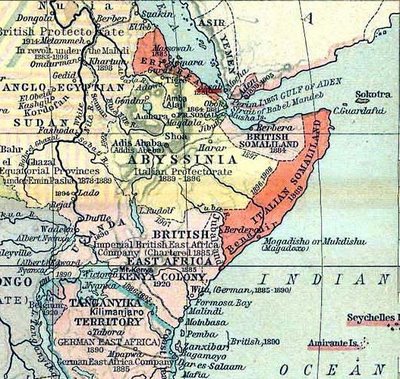
The northern coast of present-day Somalia has always been of interest for strategic and commercial reasons because of its location near the Bab El Mandeb straight at the entrance to the Red Sea. In the mid-16th century the great Ottoman Empire annexed the port of Zeila and provided protection, at a cost collected through customs and other charges, for Arab, Persian and Indian merchants who serviced the trade requirements of the surrounding area and the Abyssinian hinterland. In 1870 the ambitious Khedive Ismael I of Egypt, whose country was nominally part of the Ottoman Empire, obtained the Ottoman Sultan’s authorized rights over Zeila in exchange for paying an annual fee of sterling pounds 18,000.
The Khedive also dispatched a force to occupy Harrar in the interior, and acquired the coast between Bulhar and Berbera without reference to the Sultan. Egyptian occupation of the region continued (Khedive Ismael even briefly occupied Kismayu in 1875, near the present-day border between Somalia and Kenya) until in 1877 Britain signed a convention recognizing the Khedival annexation of all the East African coast north of Ras Hafun (the promontory of land jutting out into the Indian Ocean south of Cape Gardafui), providing that no portion of it should be ceded to any foreign power and that British consular agents should be appointed at places on the coast. The Sultan of Turkey refused to ratify this agreement even though the Ottoman Empire had never displayed interest in the coastline eastwards from Zeila, but Egypt and Britain got on with their business nevertheless.
The Egyptians found that Somaliland presented a hard, uncompromising environment for development. Behind the coast is an arid plain, extremely hot in summer, extending up to 50 miles in width that leads into a broken mountain range averaging 4,000 to 5,000 feet in height. This range, subject to periods of cold driving mist in winter, parallels the coast and slopes away to the south as a waterless plateau of gently rolling plains sometimes covered by thick grass or bush and forest. Barren areas of stony ground display many red termite mounds. This area is known as the Haud. But as Egypt had opened the Suez Canal in 1869 the interest lay in the coastline rather than the interior. At coastal locations lighthouses, harbours, piers, blockhouses and barracks were constructed, and running water supplies engineered. Many of these facilities improved the lives of the Somalis who fished or carried cargo and passengers along the coast in dhows. Those inhabitants of the region who lived as pastoralists on the coastal plain and the Haud now found a ready market for their livestock at the new ports. The British garrison and settlement in Aden, 150 miles north of and opposite from Berbera, became a big customer for Somali “meat on the hoof”.
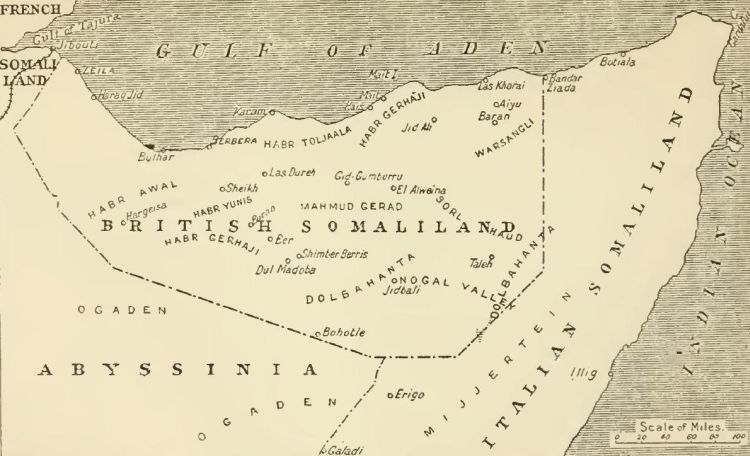 Neue Tabelle Zeile 2 Neue Tabelle Zeile 2 |
In 1884 Egypt was facing the Mahdist revolt in the Sudan and for financial reasons (dictated by Britain) had to curtail its projects along the Somaliland coast. By agreement with Britain the Egyptian flag remained flying in Somaliland but Egyptian troops and officials were withdrawn and replaced by a very few British troops, ships and officials from Aden. Aden was garrisoned and maintained by British India, but for political direction British Somaliland deferred to the British Consul-General in Egypt, Major Evelyn Baring (later the First Earl of Cromer). The Indian government’s attitude was that Somaliland had to fund itself through customs dues for all its required expenditure.
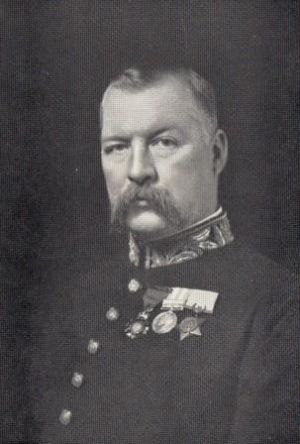 Since 1880 the British Acting First Assistant Resident in Aden, Captain Frederick Mercer Hunter, had kept in readiness for intervention in Somaliland 40 men of the Aden Police. These men were specially trained in marksmanship and the use of a three-pound field gun. Hunter selected the Aden Second Assistant Resident, Langton Prendergast Walsh (Right), who was a former Commander of the Aden Settlement Police to be a Vice-Consul and the British local commander in Somaliland. Walsh was given appointment in Somaliland as the representative of His Highness the Khedive of Egypt. Hunter installed Walsh and his 40 Aden policemen in Berbera. Zeila, still being a Turkish Pashalic (an area governed by a Pasha of Turkey) was treated separately as a British Agency, and another British officer was posted there. Meanwhile other European powers were searching this area of Africa to see what possessions they could obtain due to the Egyptian withdrawal. Germany tried and failed to get a foothold in northern Somaliland but was more successful at Kismayu (see WITU 1890 article); France secured Obock (now part of Djibouti) and later had to forcibly eject a Russian landing party that seized a fort nearby; and in 1885 Italy secured the port of Massawa (with a little covert help from the British who wanted to thwart French ambitions) in what is now Eritrea. Britain’s motives for securing the Somaliland coast lay in its strategic value to the Suez Canal route to India and its proximity to Aden, and thus other nations had to be prevented from seizing it. Once again the interior of Somaliland was of little political or commercial interest.
Since 1880 the British Acting First Assistant Resident in Aden, Captain Frederick Mercer Hunter, had kept in readiness for intervention in Somaliland 40 men of the Aden Police. These men were specially trained in marksmanship and the use of a three-pound field gun. Hunter selected the Aden Second Assistant Resident, Langton Prendergast Walsh (Right), who was a former Commander of the Aden Settlement Police to be a Vice-Consul and the British local commander in Somaliland. Walsh was given appointment in Somaliland as the representative of His Highness the Khedive of Egypt. Hunter installed Walsh and his 40 Aden policemen in Berbera. Zeila, still being a Turkish Pashalic (an area governed by a Pasha of Turkey) was treated separately as a British Agency, and another British officer was posted there. Meanwhile other European powers were searching this area of Africa to see what possessions they could obtain due to the Egyptian withdrawal. Germany tried and failed to get a foothold in northern Somaliland but was more successful at Kismayu (see WITU 1890 article); France secured Obock (now part of Djibouti) and later had to forcibly eject a Russian landing party that seized a fort nearby; and in 1885 Italy secured the port of Massawa (with a little covert help from the British who wanted to thwart French ambitions) in what is now Eritrea. Britain’s motives for securing the Somaliland coast lay in its strategic value to the Suez Canal route to India and its proximity to Aden, and thus other nations had to be prevented from seizing it. Once again the interior of Somaliland was of little political or commercial interest.
The Royal Navy initially stationed a ship at Berbera to provide Walsh with some firepower, but Hunter’s political tactics were not based on force, as both he and Walsh regarded the use of force as a failure for diplomacy. Treaties of protection were signed by the British with those Somali tribes that were amenable. Walsh recruited 50 to 60 more men in Berbera, mostly Somalis but including a few Arabs, Baluch, Pathans and Turkish deserters from Yemen. Teams were trained to operate two man-harnessed three-pounder field guns left by the Egyptians, and a couple of instructors from the 4th Bombay Rifles, Indian Army, were obtained to teach infantry skills and run a rifle range. Independent rather than volley fire was stressed, and bugle calls initiated as a means of passing tactical orders. The police were titled The Somali Coast Police. Walsh also mounted former Egyptian swivel guns on a barge and on his residence, and used some of his stock of 300 former Egyptian Remington rifles to arm a locally raised force named the Biladiehs that was hired out to guard traders’ camel convoys on inland journeys. The Remingtons could also be issued to arm friendly tribesmen when Walsh needed additional manpower to defend Berbera or Bulhar from bands of mounted raiders descending on the towns.
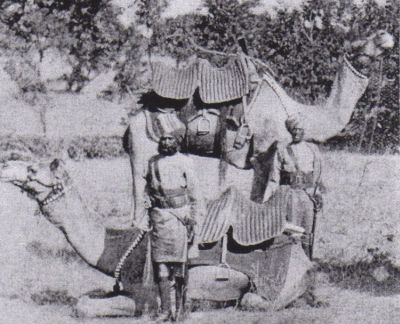
The Aden garrison also posted one infantry company (no more than 120 men) at a time to Somaliland that was dispersed as required between Zeila, Berbera and Bulhar. Detachments of Bombay Sappers and Miners could also be deployed to Somaliland for special tasks, as could a detachment of the Aden Troop, a unit of Indian Army cavalry formed to garrison Aden. Walsh also needed some mobile police and so he raised a camel-mounted detachment of around 25 men. For tactical reasons he used an Indian camel saddle that carried two men, but Somalis and Arabs were not interested in changing their own styles of solo-riding and so Walsh recruited his Camel Sowars from India.
Left: Camels with double saddles
When Somalis from the interior visited Berbera they invariably carried a shield, two spears and a short sword mounted on the waist, and these weapons could cause frightful wounds. Over time and with the assistance of the local akils (tribal and clan leaders) it became customary for the weapons of visitors to be temporarily deposited in the town police station. However on one occasion two groups of young warriors started fighting each other outside the town limits and a few Police were dispatched to stop the affray. Both groups of warriors then turned on the Police and one Afghan Constable had a barbed spear head driven through his jaw whilst another was left with one leg hanging on by a strip of flesh, necessitating amputation. A third Policeman died of wounds.
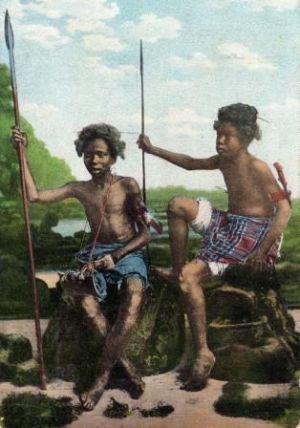 Right: Young Somali men
Right: Young Somali men
In such cases the Police requested medical support from any visiting naval ship or from an Indian Hospital Assistant eventually hired by Walsh when sufficient customs receipts became available. Wild animals also presented threats and on one occasion a lion leaped over a zareba (a defensive circular thorn-tree barrier), seized a sleeping Police sentry who should have been awake, and leaped back into the night. Next day the victim’s boots were found with his feet inside, but that was all.
From time to time punitive expeditions had to be mounted against raiders who swooped down to remove livestock belonging to tribes under British protection. A typical example was in 1888 when the Jibril Abuker clans needed disciplining, and Hunter and Walsh rode forth with their Police, Friendlies and Biladiehs accompanied by whatever elements of the Indian troops from Aden that could be spared.
Invariably the best tactic that the British could employ was to delay the raiders from returning home directly with their slow-moving stolen herds, as this delay was seized upon by all the raiders’ neighbours who immediately took advantage of the raiding parties’ absence to themselves seize the raiders’ domestic herds! On this occasion as on others the Jibril Abuker had to abandon their recently stolen stock in order to get home quickly and try to retrieve their own domestic herds from their neighbours.
A more serious situation arose in 1890 when the Mamasan section of the White Aysa tribe living on the plain southeast of Zeila made several raids on herds outside Zeila and Bulhar. The following troops were dispatched from Aden to Zeila:
2 companies of the 17th Bombay Infantry (224 Sepoys)
Cavalry from the Aden Troop (64 Sowars)
Arab Levies (20 riflemen)
A Troop of Bombay Sappers and Miners (30 Sappers)
Royal Navy personnel manning two machine guns (13 Bluejackets)
At Zeila they were joined by a detachment of about 150 men from Walsh’s Somali Coast Police, Mounted Friendlies and Biladieh Riflemen.
A garrison of 51 of the Aden troops remained in Zeilah and the remainder of the Zeilah Field Force as it was now named moved into enemy territory. On 19th January a troop of 36 cavalry Sowars raided White Aysa herds near Garissa, 50 miles south of Zeila, and after killing some tribesmen and taking others prisoner the troops removed 100 camels and a large flock of sheep. The camels and prisoners were marched back into camp before dusk, but the Sowars with the slower moving sheep were ambushed during the night and lost one Indian officer and ten men killed. Meanwhile the camp had not been well-located and had been sited too late in the day resulting in the zareba not being built sufficiently wide or high. The horses and camels were hobbled in the centre of the zareba and a perimeter defence organized. Just before dawn an alert naval gunner opened fire as up to 40 White Aysa used their spears to pole-vault over the zareba and attack the troops. Rifle fire inside the circular zareba was too dangerous to use as it endangered other defenders, so the senior officer Colonel Stace ordered a charge at the enemy by those armed with revolvers and swords. Other attackers lurking in the surrounding bushes declined to follow their pole-vaulting comrades and so the defenders cut down the intruders and cleared the zareba, but not before the British troops had suffered 34 casualties.
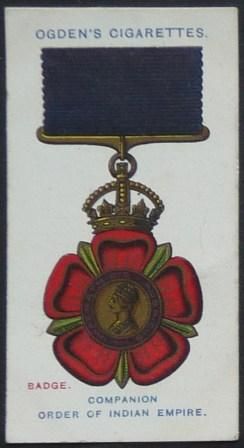 The Zeila Field Force now withdrew onto the coast and Colonel Stace, after ordering ‘No Move from the present location’, rode the 80 miles along the shore to Bulhar to signal for reinforcements from Aden. However the Aden Troop commander, Captain J.R.C. Domvile, was ambitious and he wanted revenge for his dead Sowars. Domvile moved out with the cavalry, infantry and Bluejackets to confront the White Aysa again (Walsh obeyed orders and refused to move).
The Zeila Field Force now withdrew onto the coast and Colonel Stace, after ordering ‘No Move from the present location’, rode the 80 miles along the shore to Bulhar to signal for reinforcements from Aden. However the Aden Troop commander, Captain J.R.C. Domvile, was ambitious and he wanted revenge for his dead Sowars. Domvile moved out with the cavalry, infantry and Bluejackets to confront the White Aysa again (Walsh obeyed orders and refused to move).
Another enemy ambush was successfully sprung and 13 Sowars were killed whilst half the cavalry mounts were killed or stolen. Domvile’s horseless men made it on foot back to the infantry position and another withdrawal was made to Walsh’s firm base on the coast. When Colonel Stace arrived back he found that his force was now incapable of further operations, and the Aden troops sailed back home from Zeila. As he watched the Aden troops depart Walsh received notification that he had been created a Companion of the Most Eminent Order of the Indian Empire (C.I.E.). (Left) Politically all was not lost as the offending clans, having enjoyed a good fight, now submitted and agreed to cease raiding and to allow safe passage through their territory to caravans.
Whilst the government of India had no intention of financially supporting the British administration in Somaliland, the region was of use to India. Camels were purchased at Berbera for use by Indian Army units operating at Suakin in Sudan, and Somali military labourers were attracted for the same theatre. However the latter were prevented from enrolling on religious grounds by local adherents of the Mahdi and friends of Osman Digna, these two gentlemen being Britain’s principal foes in the Sudan.
Indian Army officers began to visit Somaliland for the big-game hunting and two of them, Captain Harald G.C. Swayne, Royal Engineers, and his brother Captain Eric Swayne, 16th Bengal Native Infantry, contributed significantly to the surveying and mapping of the interior. Eric Swayne was to return to Somaliland as the British commander in the 1901 and 1902 campaigns against Mullah Muhammad Abdullah.
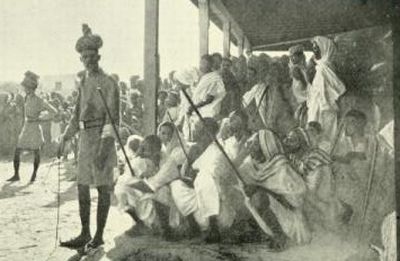 Right: Outside the Zeila Courthouse
Right: Outside the Zeila Courthouse
In December 1892 Walsh became ill whilst serving as Agent at Zeila and he was transferred to a political post in India. His time was up but both he and Hunter had, by use of a paternalistic approach accepted by the indigenous akils, contributed immensely in establishing the British administration on the Somali coast. But times were changing, Abyssinia had seized Harrar and was encouraged to move into the Ogaden – one of those “give-away” moments in colonial history that become forever regretted because of the ensuing bloodshed. The French moved their base from Obock to Djibouti and in 1894 started a railroad up into Abyssinia, thus making Zeila become a backwater port, the British ceding Ras Djibouti to France as part of a boundary settlement. In the same year the Italian Protectorate running from the east of British Somaliland to Cape Gardafui and down to the Juba River was recognized by Britain.
Professional British diplomats saw their opportunity and in 1898 the Foreign Office took over the running of Somaliland from the Indian government, Walsh and Hunter’s administrative records being deliberately destroyed in the take-over. Important new procedures for British officials were pondered over and introduced, such as what size of a gun-salute the Governor was entitled to. The following year saw the commencement in British Somaliland of one of the toughest and longest guerrilla wars that Britain had to face anywhere in the world.
_______________________________________________________
SOURCES:
The Scramble for Africa by Thomas Pakenham.
Official History of the Operations in Somaliland 1901-1904.
Under the Flag and Somali Coast Stories by L.P. Walsh.
Frontier and Overseas Expeditions from India Volume VI.
The King’s African Rifles by Lt Col H. Moyse-Bartlett.
Early Days in Somaliland and Other Tales by H.G.C. Swayne




























